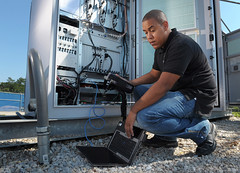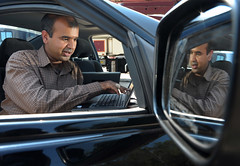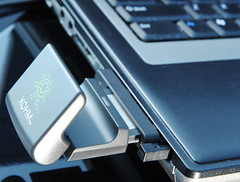 I am a geek.
I am a geek.For the first 30 years of my life, that was seen as a liability. But lately, it has been a lot more fun.
And as a geek, when I got a recent assignment from USA Today to shoot the first-ever rollout of WiMAX on a city-wide scale, I was stoked.
If you are not familiar with WiMAX, think Wi-Fi, stretching for several miles from each access point. Think 5 megabits downstream and 2 upstream in a car traveling 70 MPH on the interstate in the middle of nowhere -- WiMAX rocks. But as sexy as the tech is, my assignment was to shoot a photo of guys testing out the system.
(I don't care. I am still interested.)
And on top of the potentially boring picture part, the worry was that they might be showing up just for our benefit. That is always a concern on this kind of a newspaper shoot.
"Use your judgement," the editor said. Which is fine up to the point to where you try to figure out what you will turn in if it turns out that the whole scene is a setup.
Needless to say I wanted to light, but I did not want the gear to create a big fuss and influence the scene. So I went with a single SB-800 on a stand. Speedlights give me the ability to light quickly, portably, and without the excess gear that can influence a situation.
Flash on a Stick
The assignment was to shoot technicians testing the WiMAX gear in Ellicott City, MD, then head up to Baltimore's Inner Harbor for a rooftop installation which would afford us a full view of the city the WiMAX was designed to cover. So I knew where my lead photo would be -- on that high-rise rooftop. My plan was to shoot the techs first for the jump page (assuming they were really working) and then move on to the second site for a cool, lit-portrait lead.
"Plan A" bit the dust as soon as I arrived at the installation testing site. Turns out the next site had the antennae enclosed in a shed on top of the building. No view for me. Now the technician/testers were gonna be lead. The good news was that they were actually working, and not just for my benefit. (That was a relief.) So I stuck the SB-800 on a stand while I wondered what the heck I was gonna do for a jump page photo.
Bare speedlight on a stand is usually the first thing I do when I get to an assignment. I am almost certainly gonna use at least one, and it allows me to appear to be doing something while in fact I am wondering what the heck I am going to shoot.
True to form, the tech was working in the strong shadow created by the morning sun. Ten years ago, this would have pissed me off as I resigned to use on-camera fill flash. But today I see this as a blessing -- it gives me nice diffuse light a few stops off of my main ambient exposure in which to build some directional light.
Looking at the photo up top, with sun coming in from back camera right, the obvious key light position is gonna be from front camera left. This crosslights the tech who is wearing a branded XOHM shirt -- as I am sure he does every day even when newspaper photogs are not there shooting him. (Hey, at least he is doing real work. I'm not complaining...)
But that key light is gonna leave me with dark, harsh shadows both on my technician and in the area where he is working. So I stuck another SB on my camera to reach up in there and provide some fill. Now we have a no-fuss, three light setup: Sun back/right; key front/left and fill from on-axis.

In a situation like this, shooting in manual is probably gonna make more sense than TTL. Reason is, that highlight on the panel at left is gonna change as you change your shooting angle. And it could very well influence your TTL response. I used both TTL and manual in this shoot, but ended up in manual just for that reason.
For a trigger, I fired my fill light on-camera and slaved the SB-800. Dear Lord, I love those perfect little flashes.
Last week, we talked about how to do this in TTL mode. It is very easy in manual, too. Crank the ISO down low. Shutter at 250th of a sec. Choose an aperture that gives you a nice, rich exposure. Bring your key light in against the ambient on manual power until it lights your subject well.
Generally, in a situation and working distance like this a 1/4-power manual shot is gonna get you very close. If it is not dead-on, it is in the ballpark for an easy, quick adjustment.
The key-to-subject distance is fixed, so nothing changes as long as your ambient is constant. If the sun goes behind the clouds, open up your shutter to adjust your ambient and then keep shooting. It's so easy, even a photographer could do it.
The one variable you'll need to keep an eye on is the on-axis fill if you are working in manual flash. I dial in the power level until the fill looks good in the screen on the camera back. Then I adjust it, based on whether or not I move in or out from the subject. Remember, this flash exposure is going to change as your camera-to-subject distance changes.
But you can use your movement as a quick flash adjustment, too. If I need a tad more fill light in manual I may just move in a foot or two and zoom out to compensate. Presto, your manual fill flash is brighter. You get the idea.
I knew a wrestling shooter who used to fine tune his focus that way before the days of autofocus. He would just sway to and fro as he shot, looking like he was lost in some sort of religious chant. Worked, too. Or maybe he was praying for sharp photos. I certainly have done that on occasion.
Back to the light, the on-axis fill defines the contrast range of the photo. Ambient sets the environment, key light properly exposes the subject and on-axis fill dials in the shadow contrast. He wasn't doing anything sexy (unless pumping stream after stream of throbbing test data through a network turns you on) but I was able to get quite a few different looks very quickly with this lighting setup.
On to Plan B
So, now that the skyline is a bust and the jump photo has just bubbled up to the lead, I need a new jump photo. A few questions later, we find out that other engineers are testing WiMAX bandwidth with mobile laptops nearby.
That is not the kind of photo that would normally excite me. But compared to not having a jump photo, it is absolutely fantastic. A half hour later we caught up with them, sitting in their car in crappy overhead light.
 Once again, what I used to consider as a liability is now an opportunity. My guy is sitting in a car in backish/overhead light, working on a laptop in a car. (Yeah, I know -- they can't all be firefighters tossing babies out of burning buildings.) But, like I said, compared to having no jump photo I'll certainly take it.
Once again, what I used to consider as a liability is now an opportunity. My guy is sitting in a car in backish/overhead light, working on a laptop in a car. (Yeah, I know -- they can't all be firefighters tossing babies out of burning buildings.) But, like I said, compared to having no jump photo I'll certainly take it.Again, bare flash on a stand makes easy work of a guy in a car. I just walk it around to the front of the car and aim it through the front windshield by sighting the angle from the flash. I aimed it to hit his face from a profile-to-slightly-backlight position. I set the flash on 1/4 power (I hang out there a lot) and walked around to check the intensity and direction of the light.
Direction was good, but the light level was a little off. A quick adjustment of the flash's power level and I was in business. Trigger on this setup was a Pocketwizard. (Since I was not using on-axis fill, I had no light to trigger the key via optical slave.)
Are these sexy, glamorous photos? No. They are simple, block-and-tackle, hit-for-average shots that define what you settle for on the low end of the quality scale.
I have said it before, and I will say it again: I consider these photos just as important to light effectively as is the bigger stuff. All the more so, really, when you consider that what you do with these types of jobs define the "floor" on range of what you produce.
CYA With a Detail
One last thing. Like Bob Hamilton, my DOP at The Sun, used to tell me: Always look for a detail photo.
If you get into a practice of grabbing at least one relevant detail on every assignment, you frequently will save a page designer's butt. And occasionally you'll save your own. And if your light-on-a-stick is already set up, adding dimension to the detail shot is a very easy thing to do.
 For this close-up shot of the XOHM WiMAX card, I already had back/overhead key from the sun. So sticking my flash down close to the ground in front and uplighting the card was the best way to cross light it to give it a little more pop. Nothing earth-shattering, but it gives a secondary highlight and makes it look better than a one-light-source shot.
For this close-up shot of the XOHM WiMAX card, I already had back/overhead key from the sun. So sticking my flash down close to the ground in front and uplighting the card was the best way to cross light it to give it a little more pop. Nothing earth-shattering, but it gives a secondary highlight and makes it look better than a one-light-source shot.Did I mention how much I love those 5-section, compact light stands? This is one reason why: You can crank them down to the height of a tiny background stand for a quick uplight when you need it.
Again, nothing sexy. But being in the habit of lighting the details (and shooting them, for that matter) is a good work ethic and will pay you dividends down the road.
_________
NEXT: On Assignment: Manil Suri




0 comments:
Post a Comment